Willemien de Villiers is a South African artist and member of the 62 Group. Her long career spans sculpture, painting and stitching. In her work, she often explores the themes of connectedness through nature as well as gender inequality, misogyny and patriarchy.
In her stitched work, Willemien creates detailed, intricate and interlinked pieces based on her feelings of our deep interconnection to the world at a cellular level. Creating through a slow, meditative practice to mimic the passing of time in nature, she chooses to work on pre-used fabrics with obvious signs of wear. Her attention to the reverse side of her work enhances the feeling of interconnection by raising the importance of what is hidden behind the surface.
She is intrigued by the patterns found in biological cells and uses repeat patterns, integrating them with existing marks and stains on old fabrics. In her latest works, she expresses strong feminist statements about the power dynamics in a marriage.
In this article, Willemien shares how she developed her recent Subversive Bride series based on the concept of a trousseau. These works are abstract representations of a bride’s trousseau dreams and hopes. She sews onto used tablecloths and other domestic fabrics, incorporating their stains to explore patriarchy and the restrictions on women that still exists in most cultures.
Name of piece: Bride 1
Year of piece: 2018
Techniques and materials used: Hand stitching, staining of used vintage domestic textiles including lace and cotton embroidery floss
Size of piece: 76cm (w) x 74cm (h)
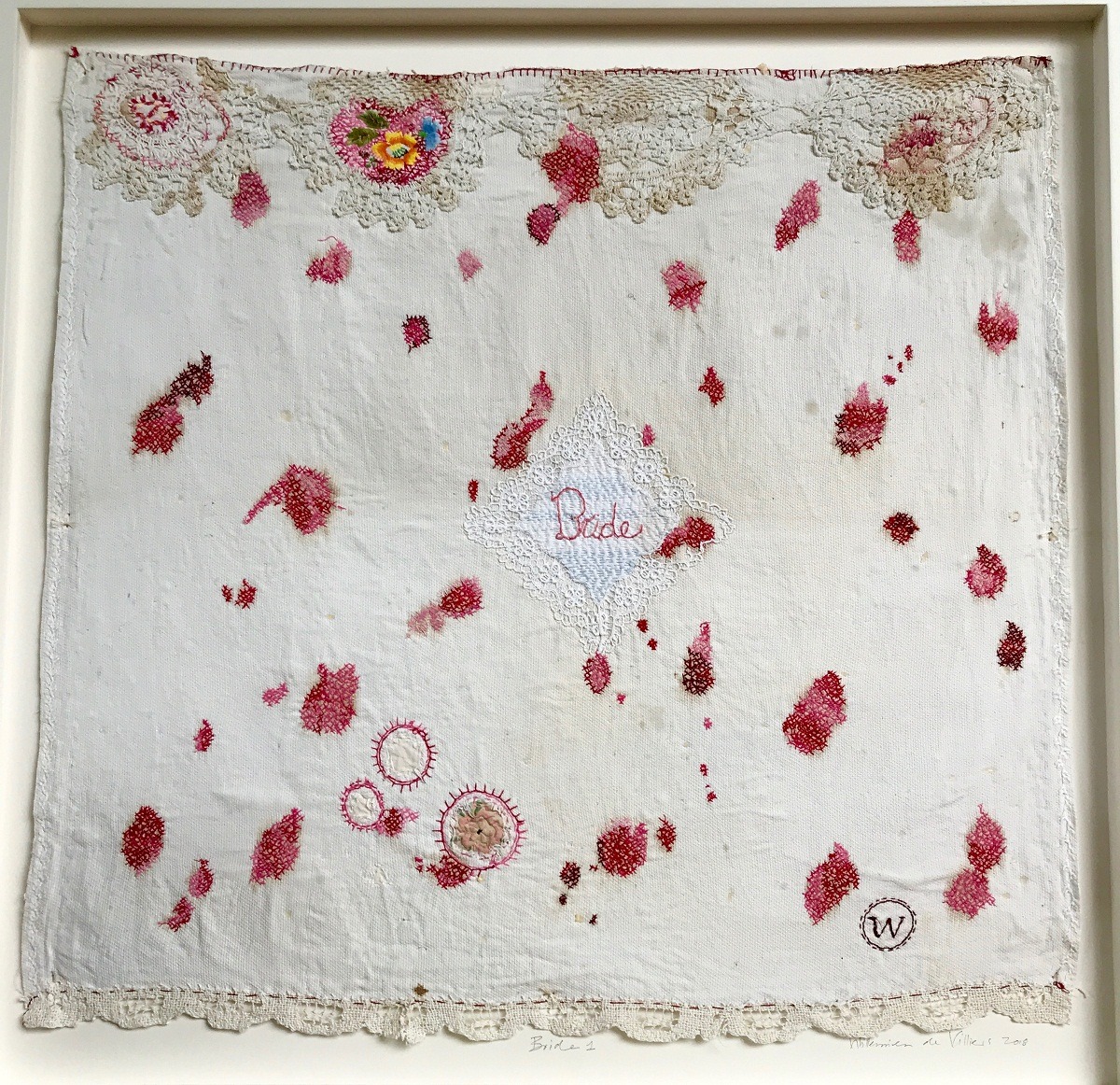
Inspired by the life of an old tablecloth and its previous owner
TextileArtist.org: How did the idea for the piece come about? What was your inspiration?
Willemien de Villiers: The Subversive Bride series was inspired by a very large tablecloth my sister-in-law gave me that once belonged to her grandfather’s first wife. She knew that I would love the look and feel of the old, soft fabric. It was a cotton-linen blend that was probably hand-spun and woven in Germany.
She was hoping that I could make something to honour the life of this woman, who had captured her heart and imagination. Her name was Martha Lochte and she left Germany at the turn of the previous century to join her fiancé, who was already stationed as a missionary in the dry, arid Western Transvaal region of South Africa. They were married for over twenty years and she died childless age 54.
The fabric was made up of four panels, joined with broad bands of crocheted cotton lace. The moment I first spread open the vast cloth in my studio I tried to imagine the life of this missionary’s wife. She was so far away from friends and family, in a place very different from her home. The stains and small mended areas spoke to me of frugality, generosity, duty and love.
The word “bride” kept entering my mind. I started seeing the tablecloth standing in for a bed sheet and with the food stains, stitched in red, becoming the monthly bloodstains the barren Martha must surely have resented.
I wondered whether I was presuming too much.
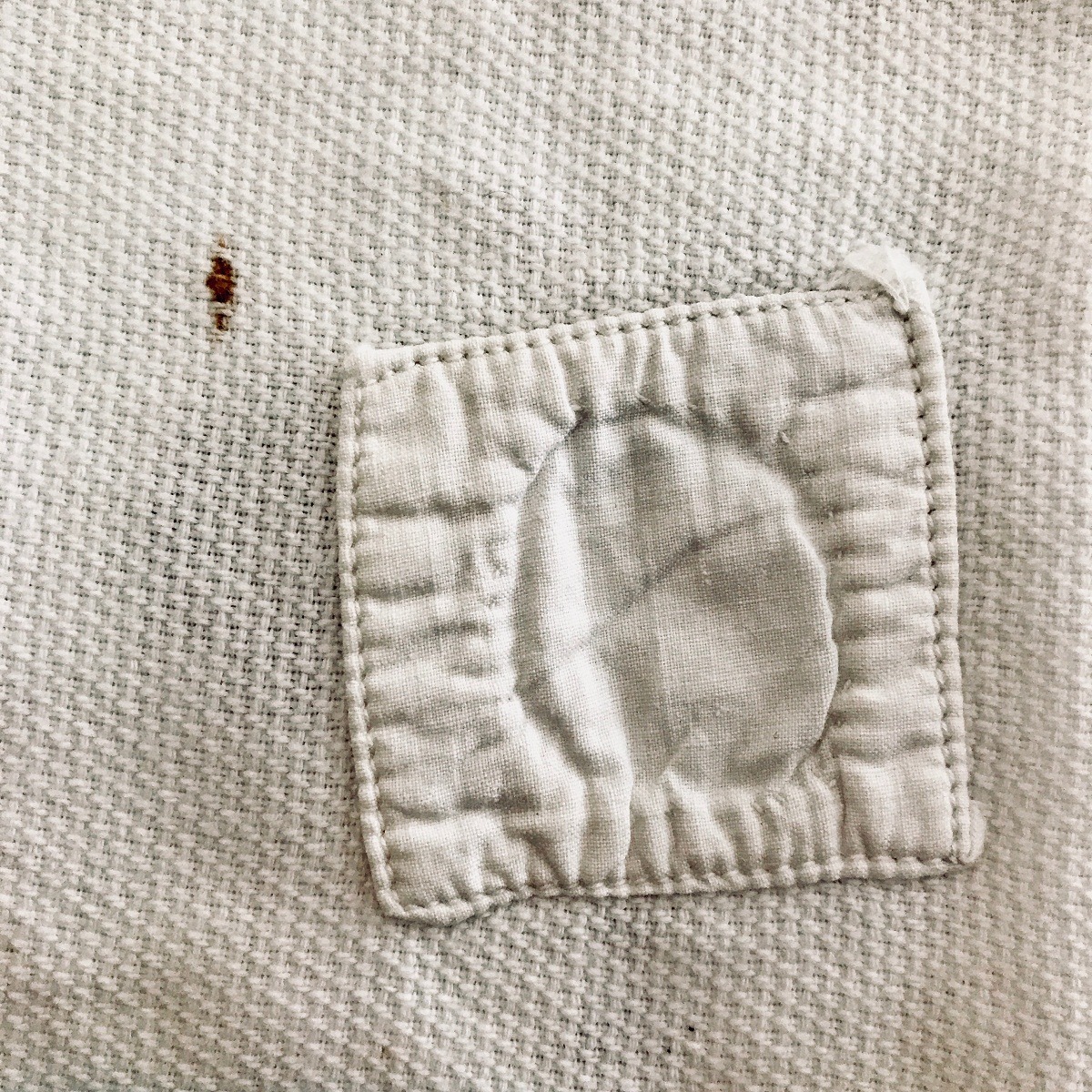
What research did you do before you started to make?
I started reading widely about marriage rituals in various cultures. I became intrigued by the tradition (which I had all but forgotten) of collecting domestic kitchen and bed linen for the bride’s ‘trousseau’, ‘bottom drawer’, ‘hope chest’ or ‘glory chest’.
Old fashioned as it might seem to most young brides today, it’s still very much in use in many societies.
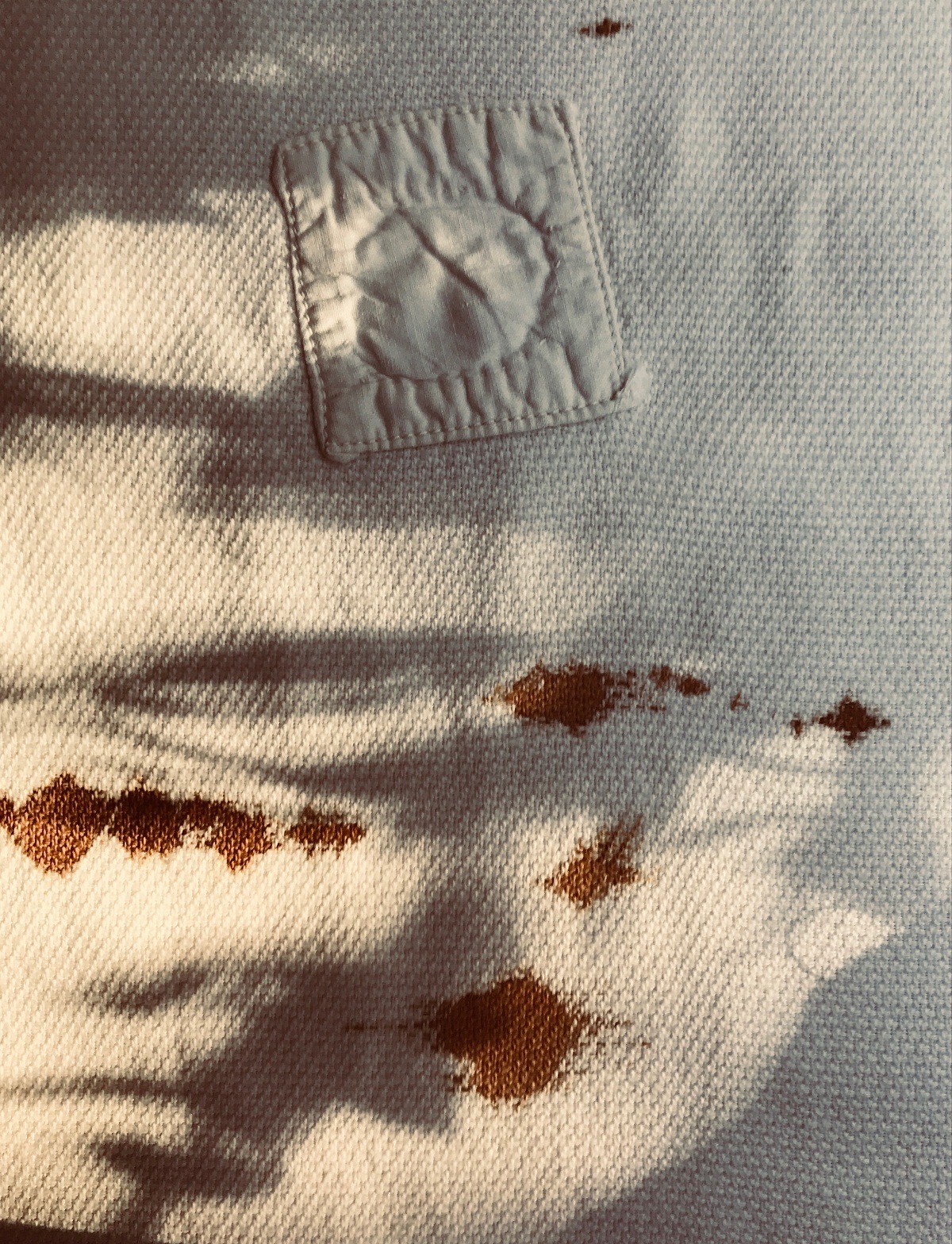
Deconstruction and rebuilding; incorporating the fabric’s history, stains and all…
Was there any other preparatory work?
I tore away the crocheted lace and divided the plain areas into several smaller pieces. I dripped various stains onto the lace and draped it over the burglar bars of my studio to dry.
I had managed to deconstruct Martha, reducing her life to a tidy pile of frayed cloth and stained crocheted lace.
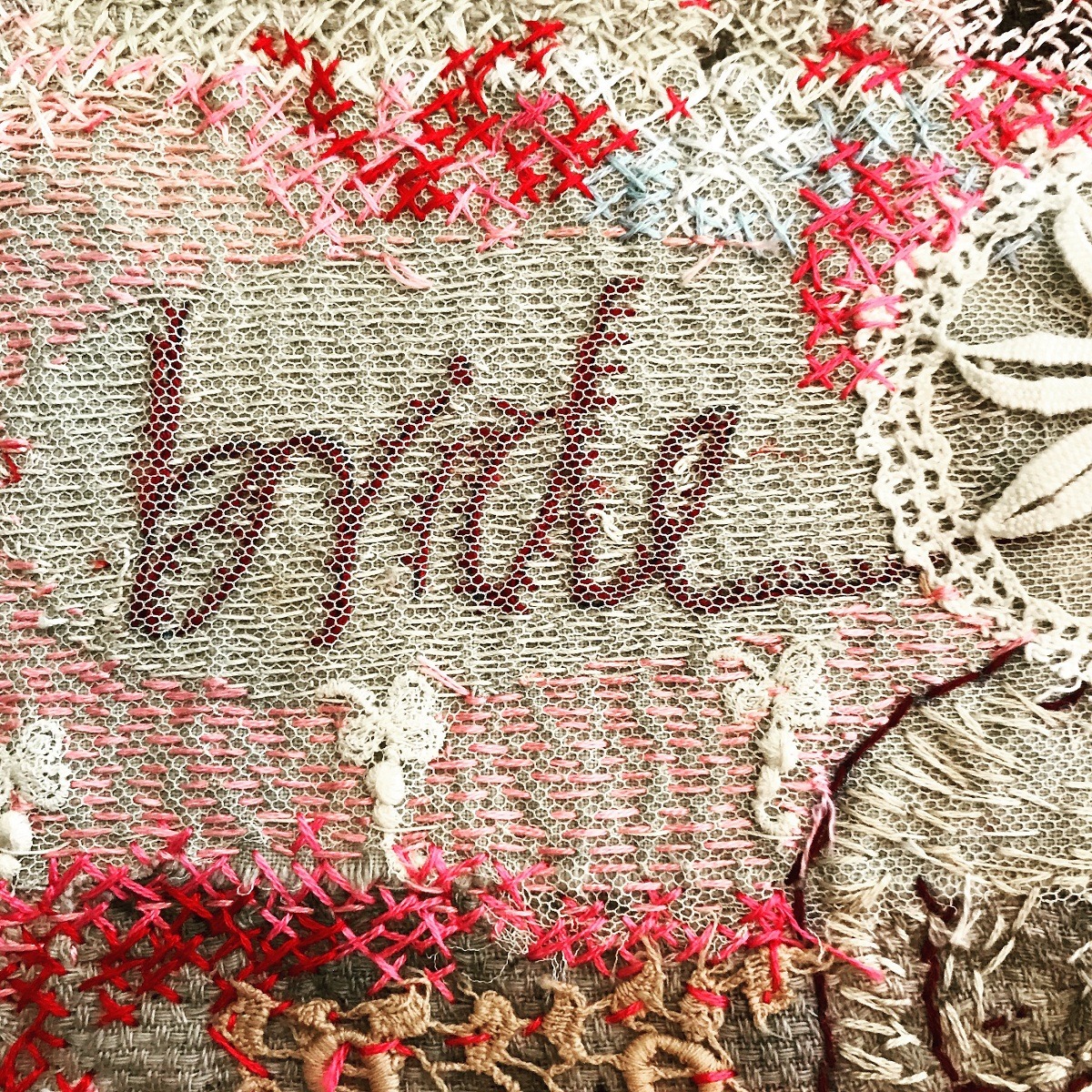
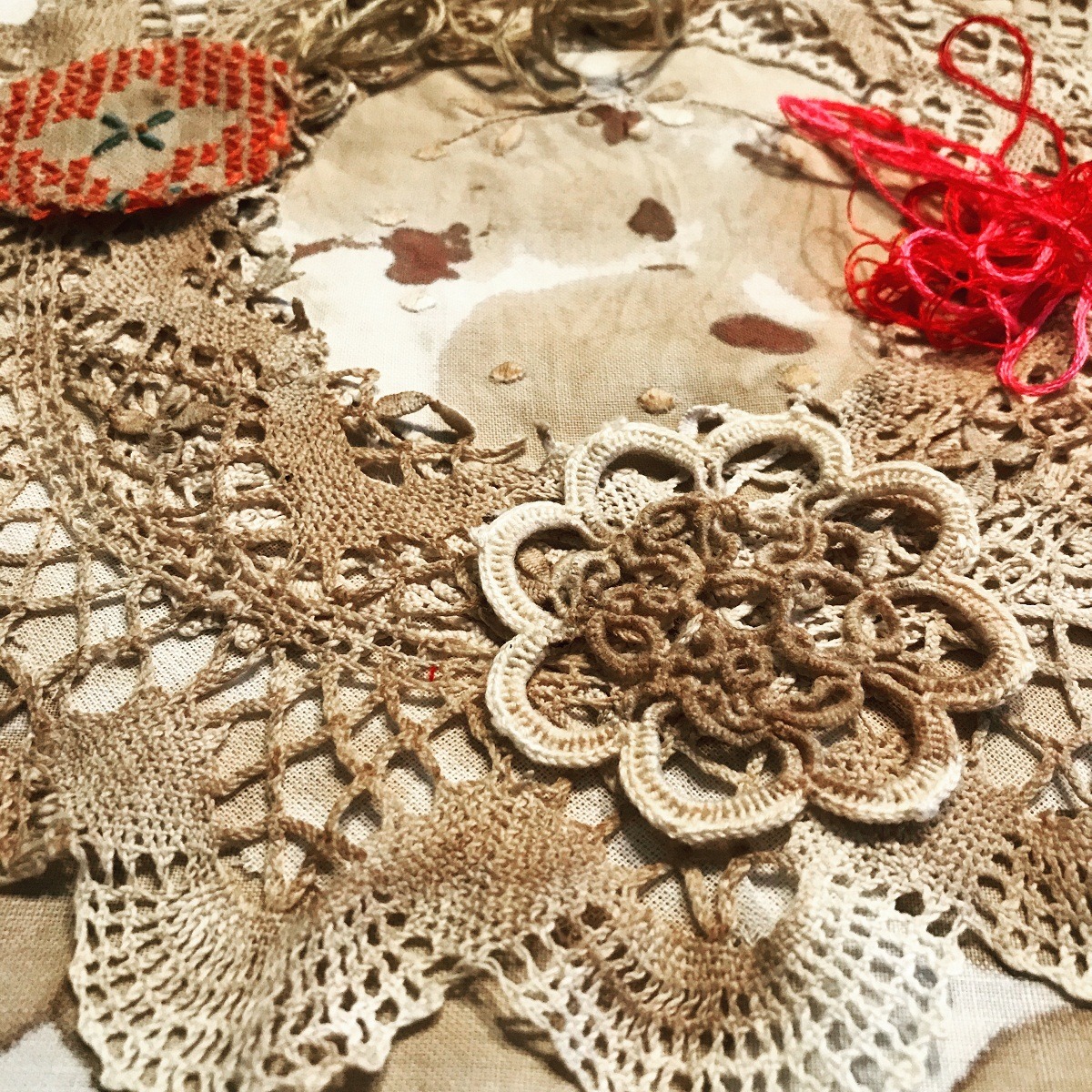
When I posted the first image of this emerging series on Instagram, using the tag #subversivebrides for the first time, I asked people to share their feelings about the word “bride”.
I was overwhelmed by the response. Clearly, I had hit a nerve:
“There are so many centuries of layers of experiences bound into that one word. Highly charged and evocative.”
“I know it says bride… but I fleetingly thought it said bade … as in bade farewell. Nice double meaning.”
“This really stirs up emotions in me… There is something about the combination of old linens, embroidery, soiling, and the red stitching that really gets to me. It’s like the fairy-tale promises made to young girls meeting gritty reality.”
“All those stitched down edges, the over sewing with ‘the feminine’. Like a mask or makeup.”
“Because I’ve been married twice, I appreciate how you covered the word bride in lace after stitching it in red thread. The word bride has many layers of meaning for me, and many emotions as well. I would say I actually felt most like a bride when I danced with my dad at my second wedding. I felt sacred and ready and aware of being a woman with a relationship with self and with others.”
“Disappointment, vain hopes…”
“Bride; this magical and round word contains dreams and hopes, the project of a life. Youth, fairy, unreal, brightness are words that for me go with it. This same word in French needs just a little accent on the “e” to make “bridé” and that means limited, restrained…for some women that can be the day after the wedding ceremony…”
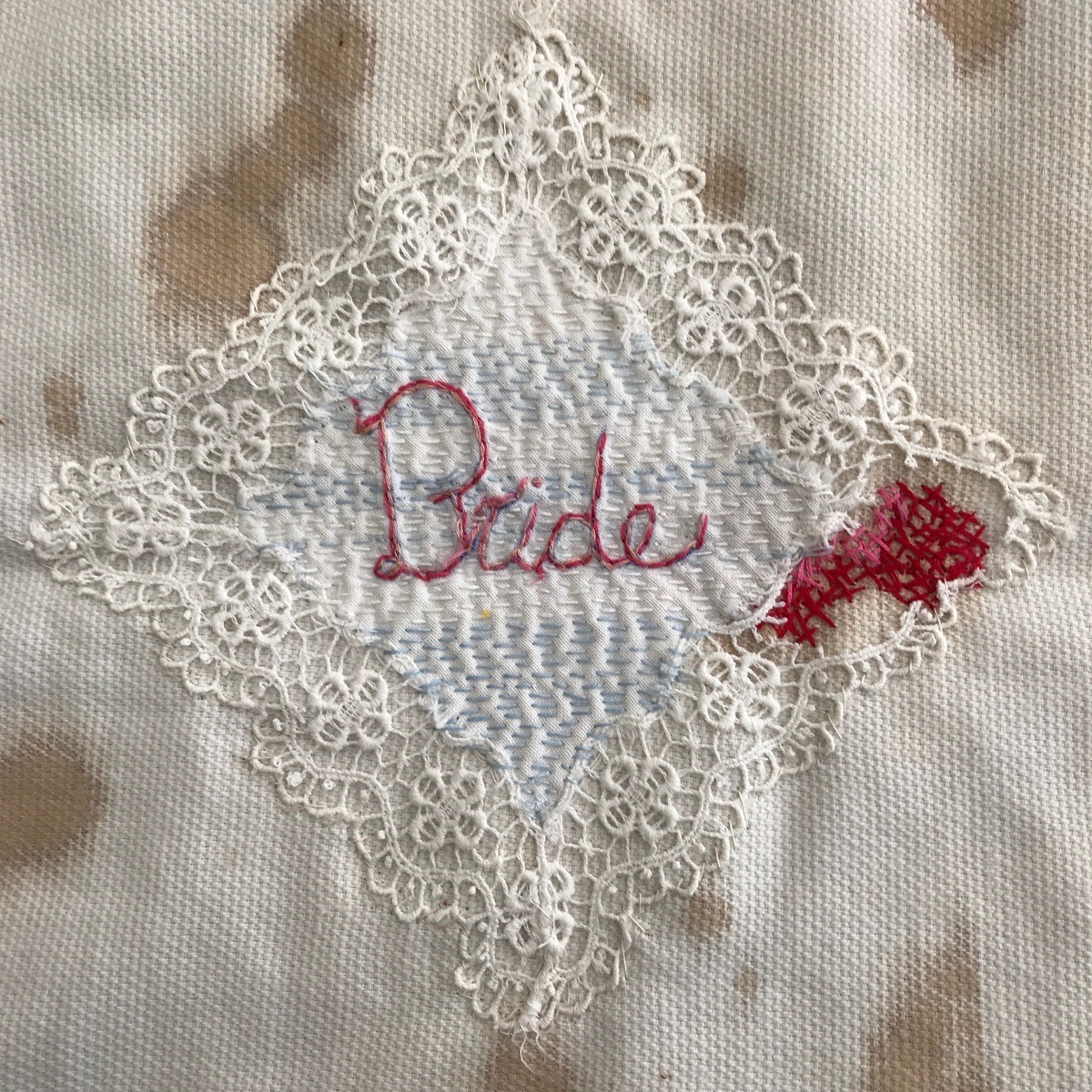
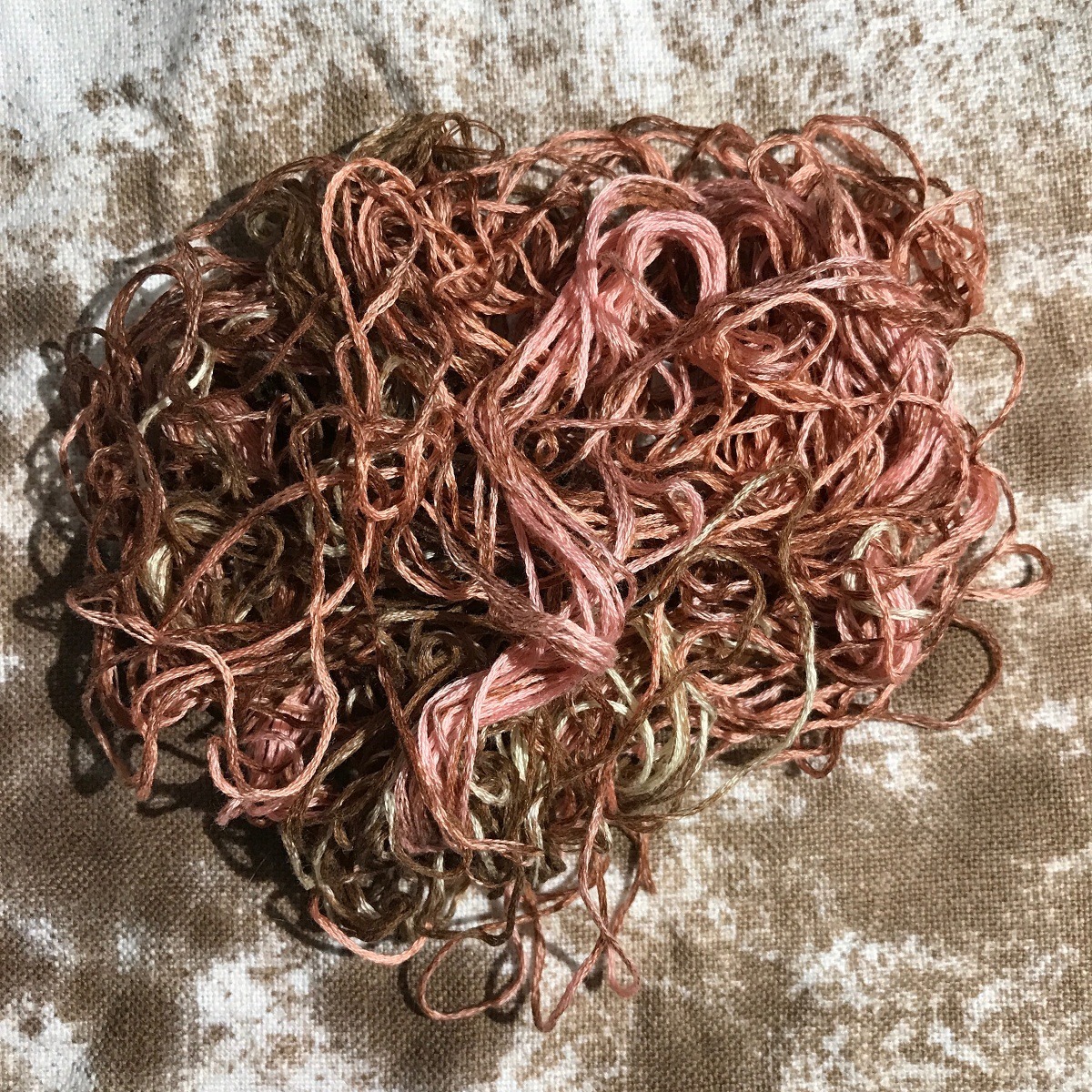
What materials were used in the creation of the piece? How did you select them? Where did you source them?
My latest works in this series are abstract representations of these trousseau dreams and hopes. In my home language, Afrikaans, trousseau translates to “Bruidskat”, the bride’s ‘treasure’.
I view these small works as meditations on marriage and the power dynamics entrenched in such a union.
I chose a range of pink embroidery floss to stitch with pink. My current obsessive use of pink is also in long overdue defiance to my university art professor who once told me that no-one will ever take me seriously as an artist if I don’t “stop using so much pink”.
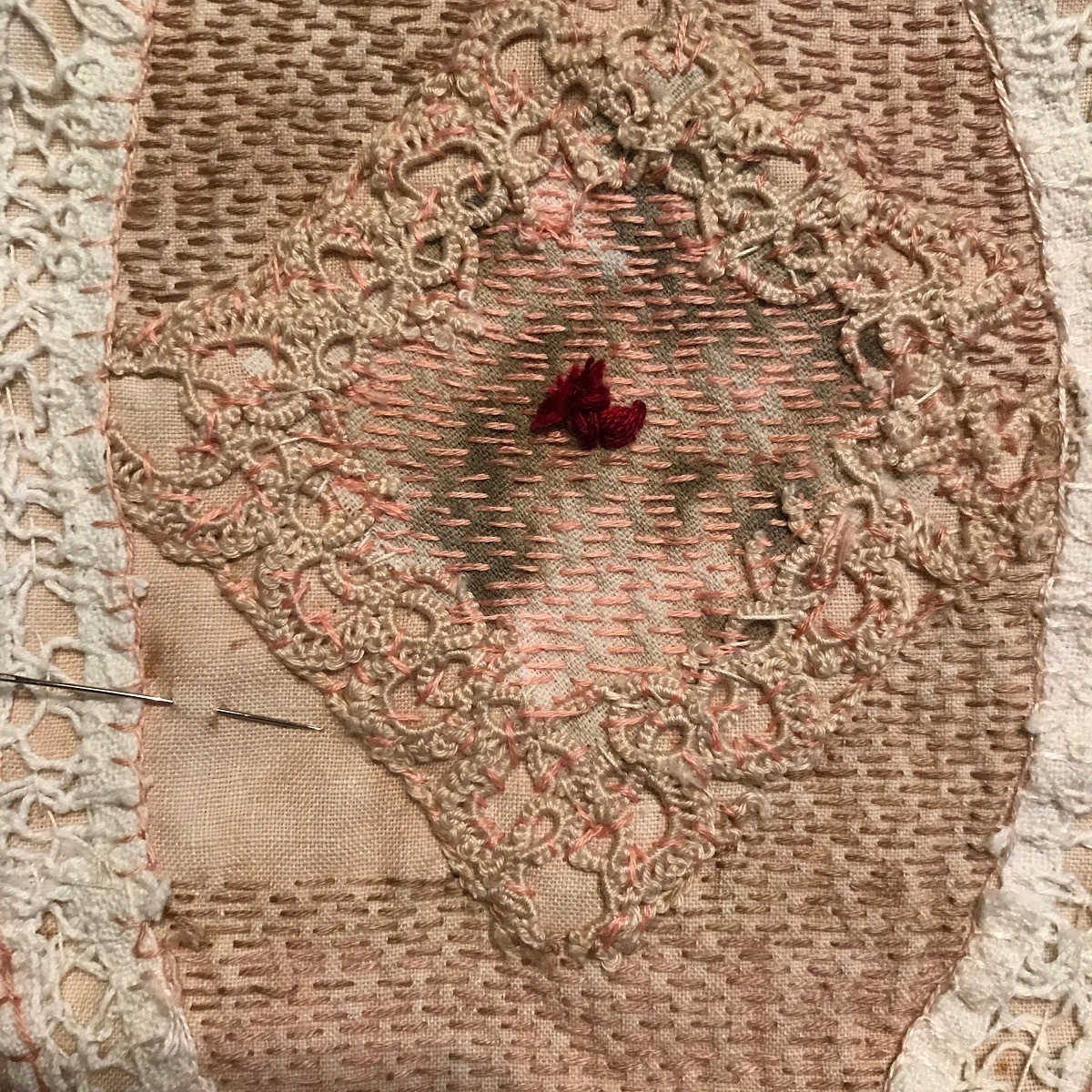
The process of making my work is very simple and straightforward. I always use vintage domestic linen such as napkins, tablecloths, tea tray cloths as my base cloth. The more damaged and soiled, the better. I find them in charity shops or from friends who know me well.
I sometimes add more stains by using foodstuffs like red wine, turmeric, tea and coffee.
The idea of the Instagram tag #domesticstains excites me, as a metaphor for the habitual sanitising of women’s messy, and often devalued, lives. And of course, women are still mainly responsible of dealing with the stains (literal and figurative) of day-to-day domestic life.
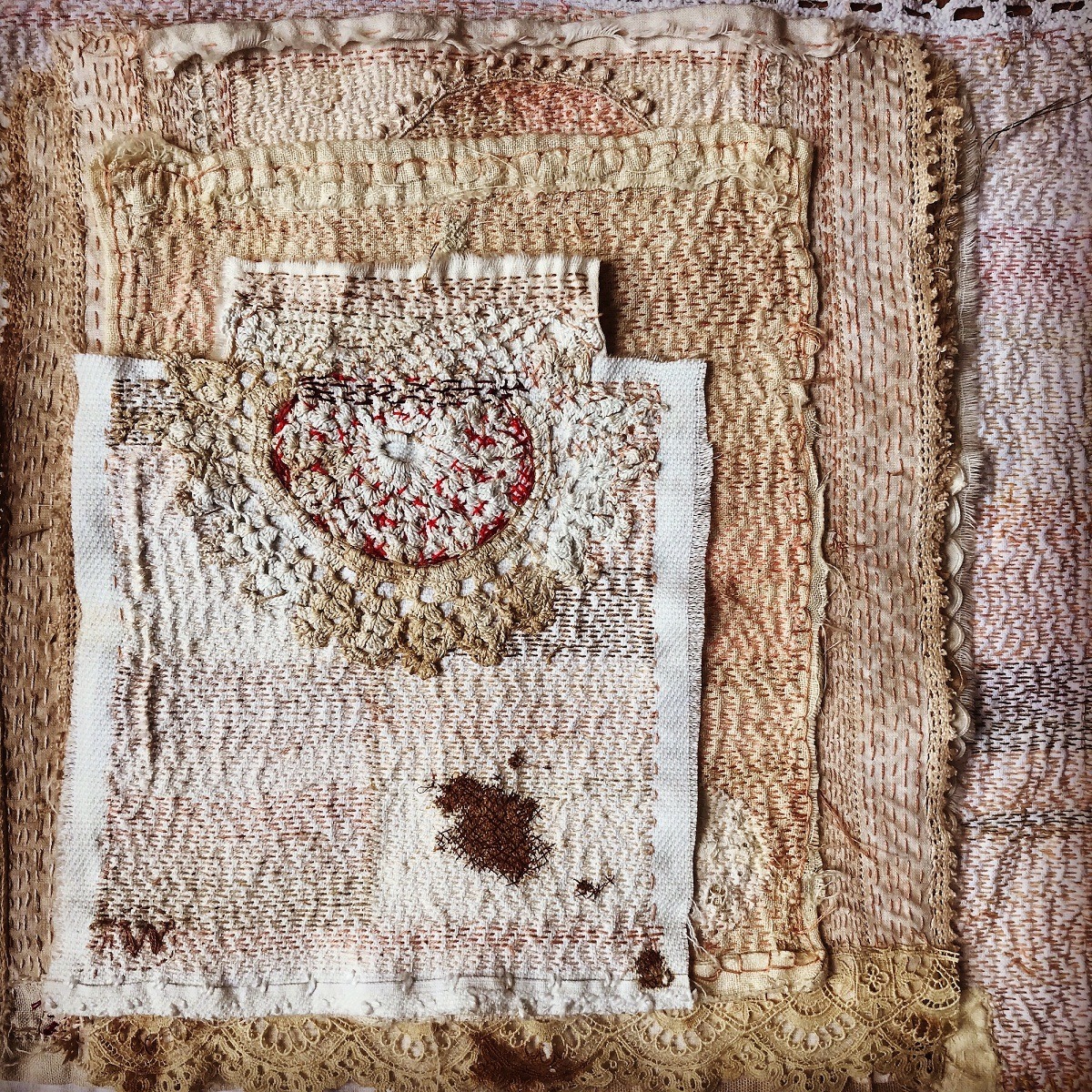
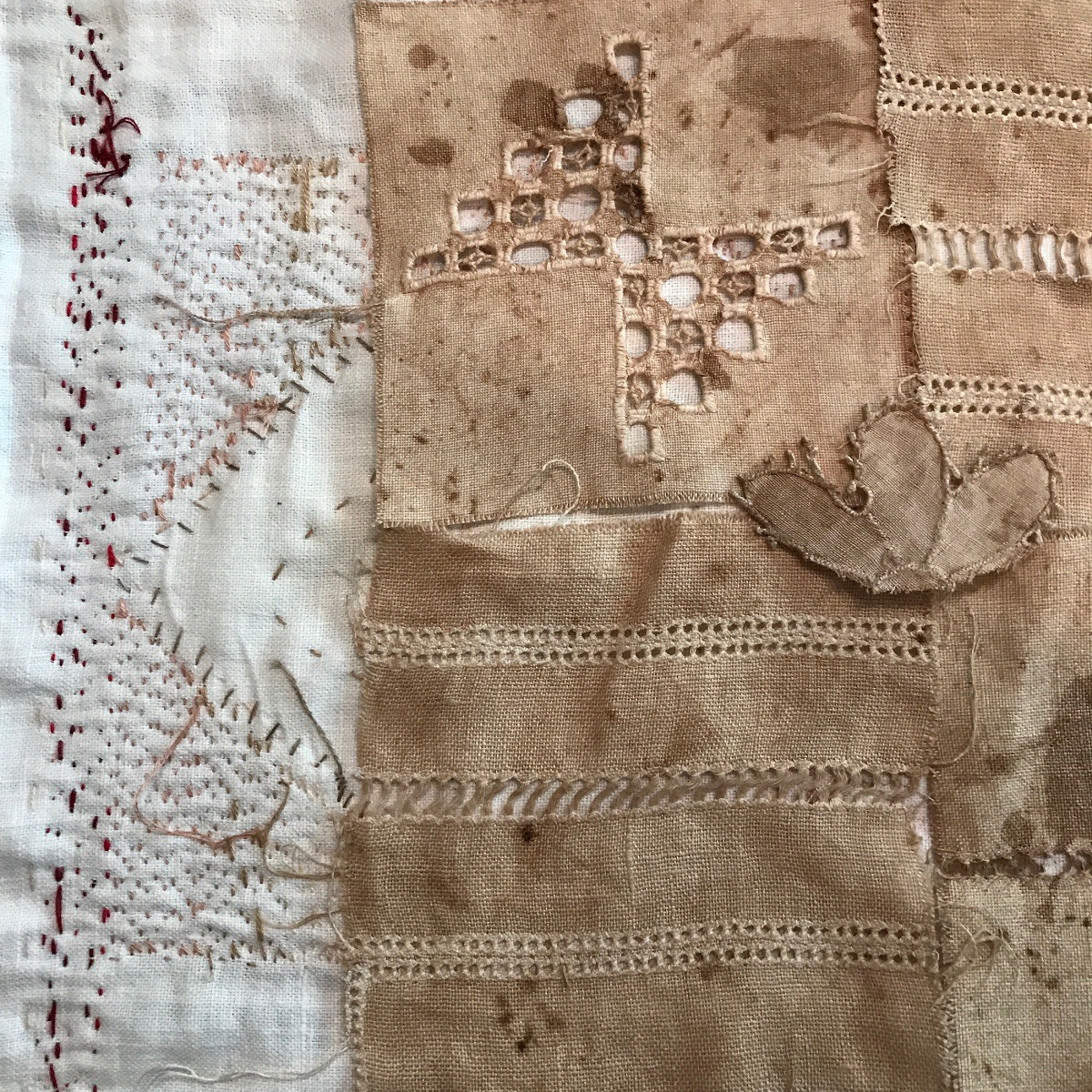
Using pink thread as a statement
Take us through the creation of the piece stage by stage
Once I’m satisfied with the level of staining of and damage to my base cloth, I tack it to a bottom layer. This helps to add texture to the stitching of the final piece. For this backing layer, I use a plain piece of calico or muslin.
I like to linger at this beginning section of the work for as long as possible. I spend time smoothing the fabric, folding and unfolding, fraying the edges and searching through my very large collection of torn bits of lace and old embroidered cloth.
Immersing myself in this tactile experience, my mind seeks patterns, colours, texture.
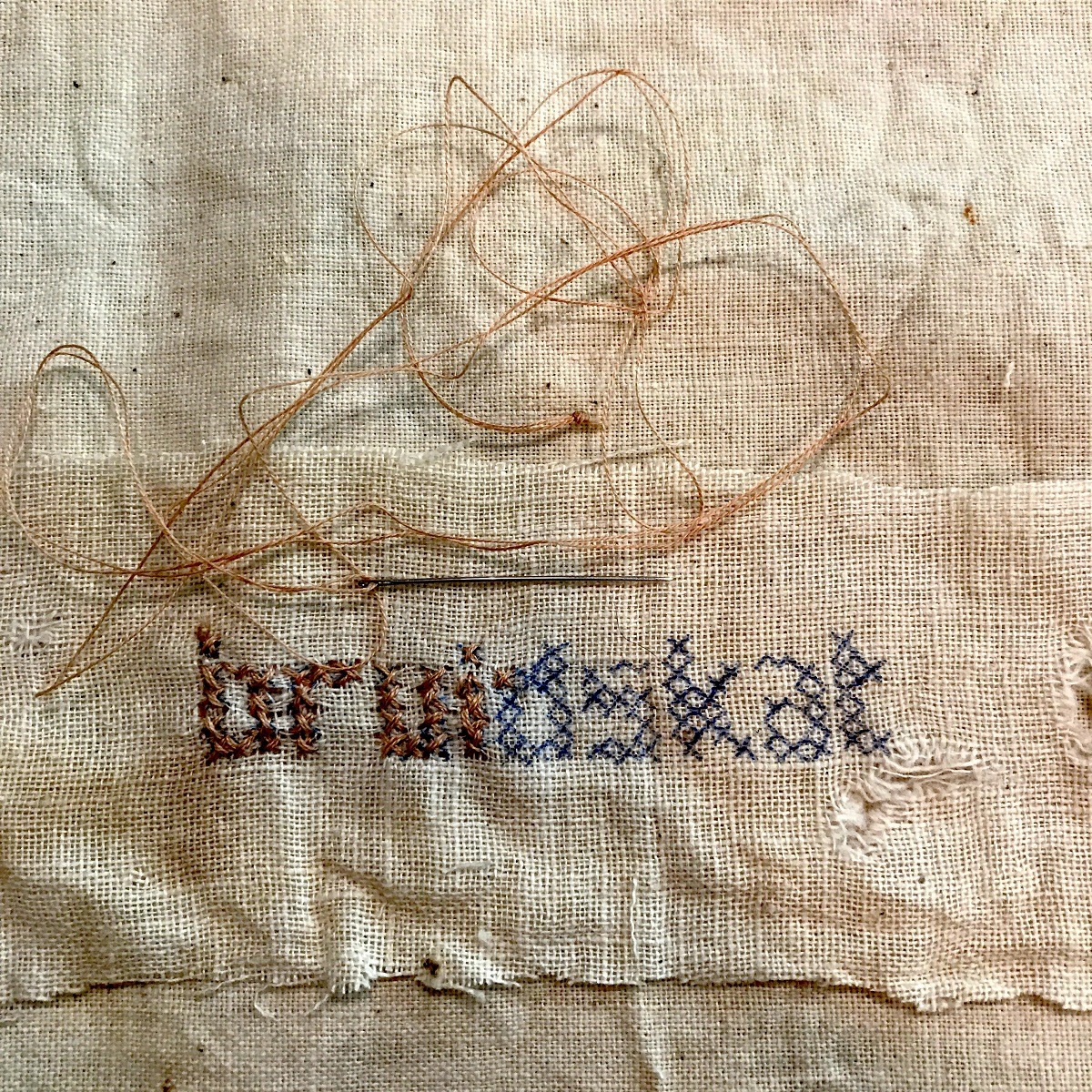
At the moment, I’m using a limited palette of dirty pink, walnut browns and deep red. I sometimes dye the more pure, bright pink embroidery floss with walnut ink to mute the colour. And so the Instagram tag #mutedpink was born; an apt reference to the narrow, toned down lives so many women are still expected to live.
I use a combination of mending-stitch, cross-stitch and blanket stitch in my work, allowing the process to develop organically.
I don’t do preliminary sketches or any other kind of planning, except for finding the perfect smaller items to appliqué onto the base cloth.
Stitching by hand remains the best form of meditation I know. Slowly but surely, through the repetitive action of one stitch at a time, my hand and mind connect to my heart and a new work is born.
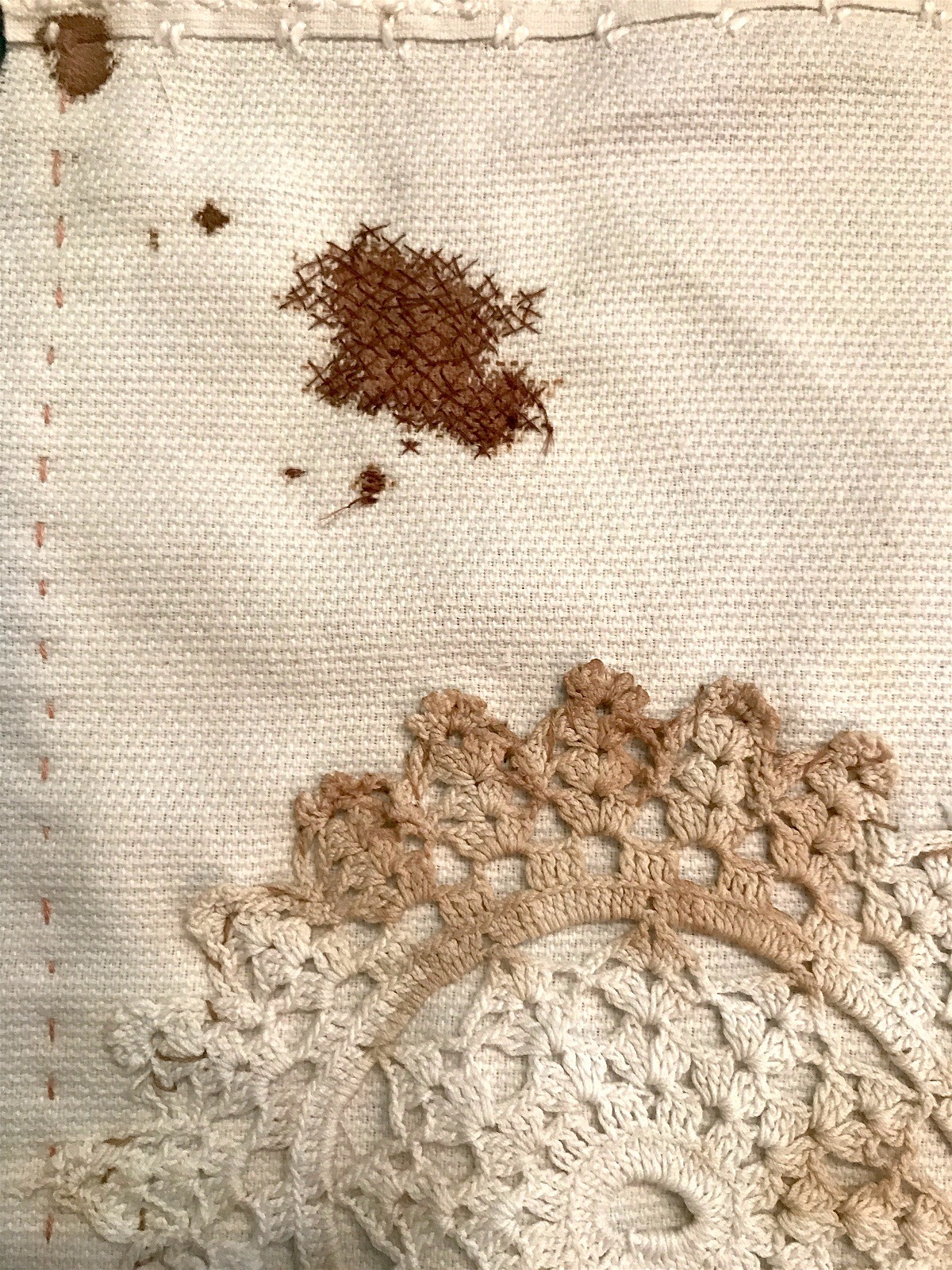
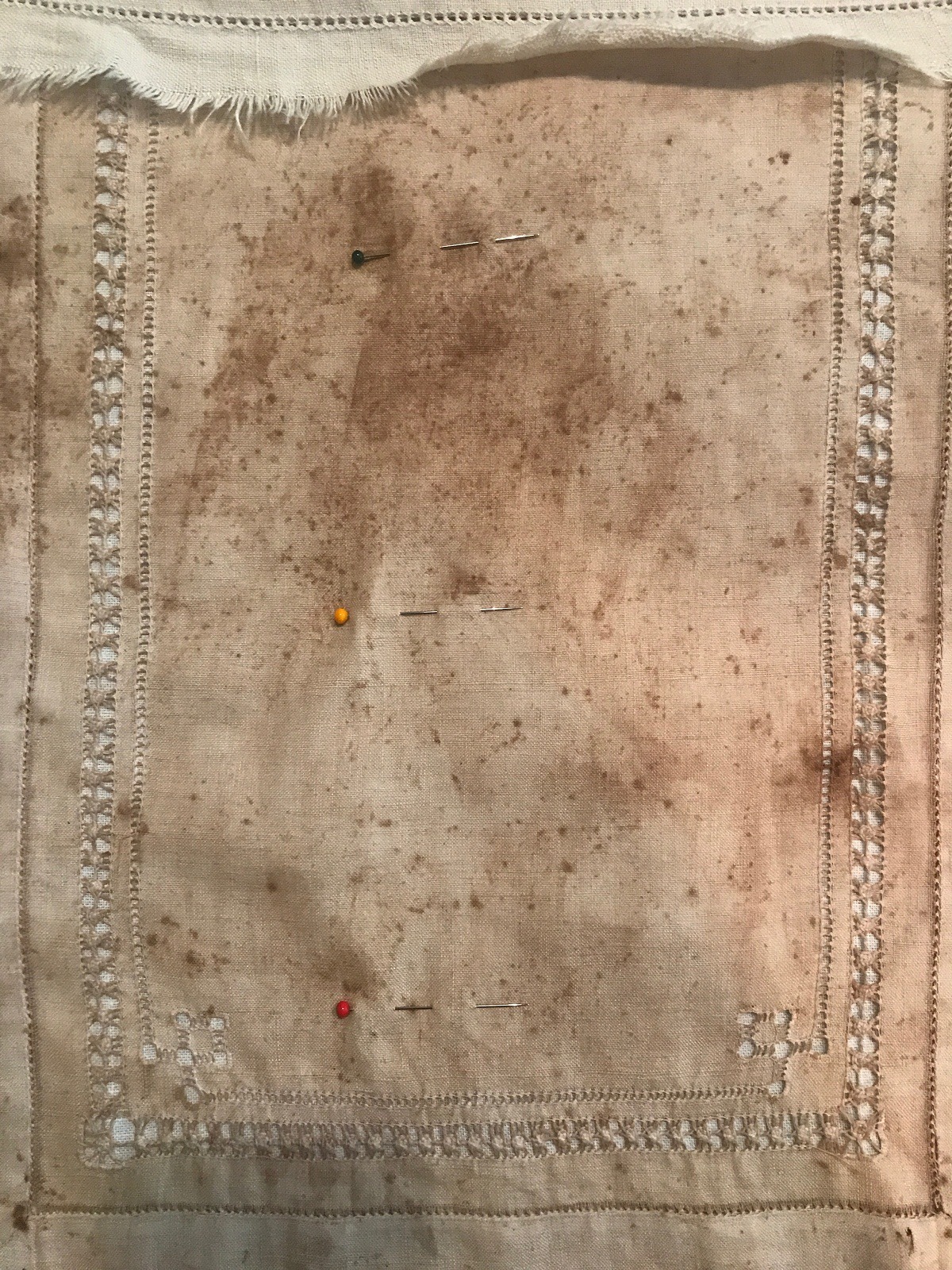
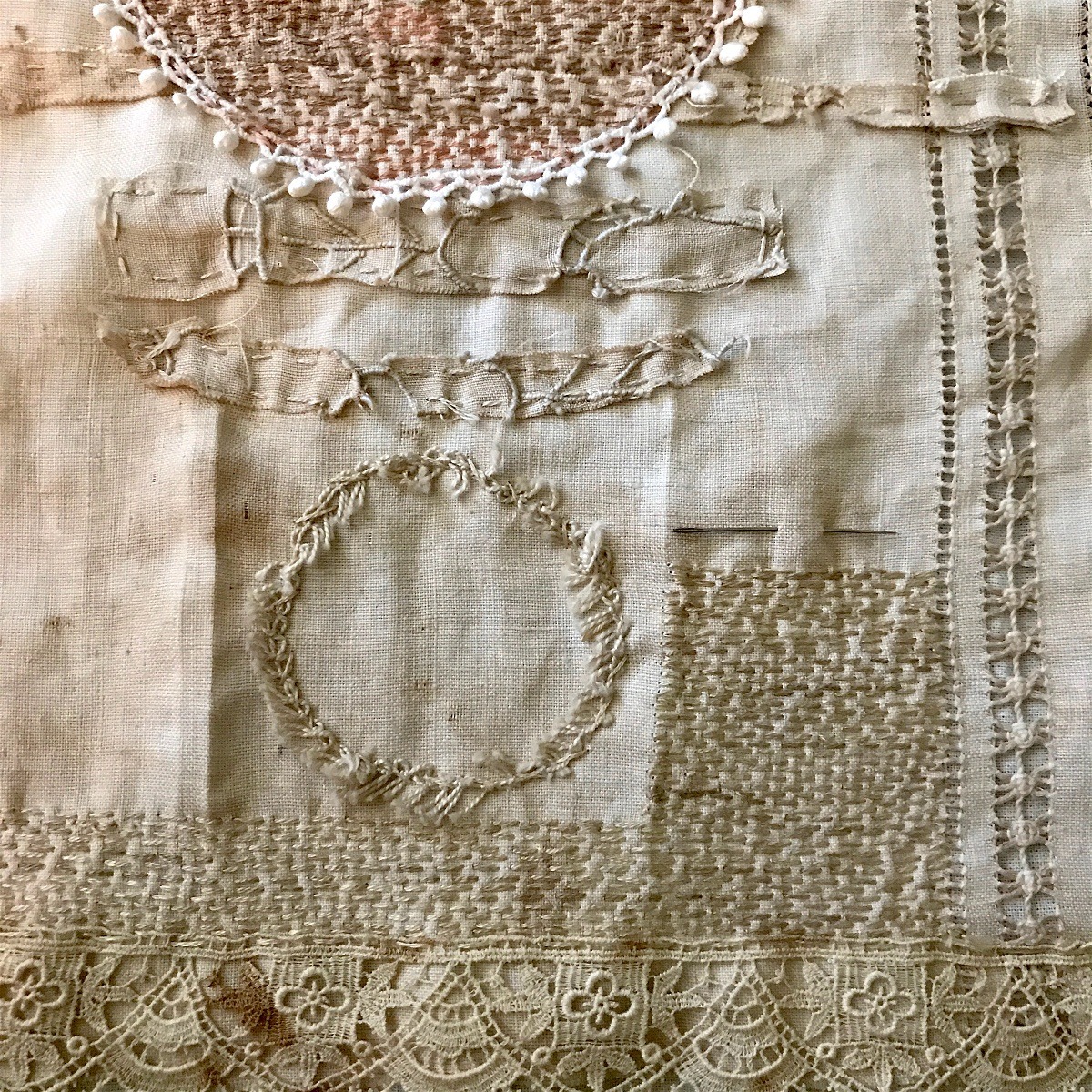
What journey has the piece been on since its creation?
The first two works in this series, Bride 1 and Bride 2, were exhibited at the Pretoria Art Museum in Gauteng (South Africa) as part of a group show (Unfolding Fibre).
The Subversive Bride Trousseau series was exhibited in October 2018 at the IsArt Gallery in Franschhoek, Western Cape (South Africa).
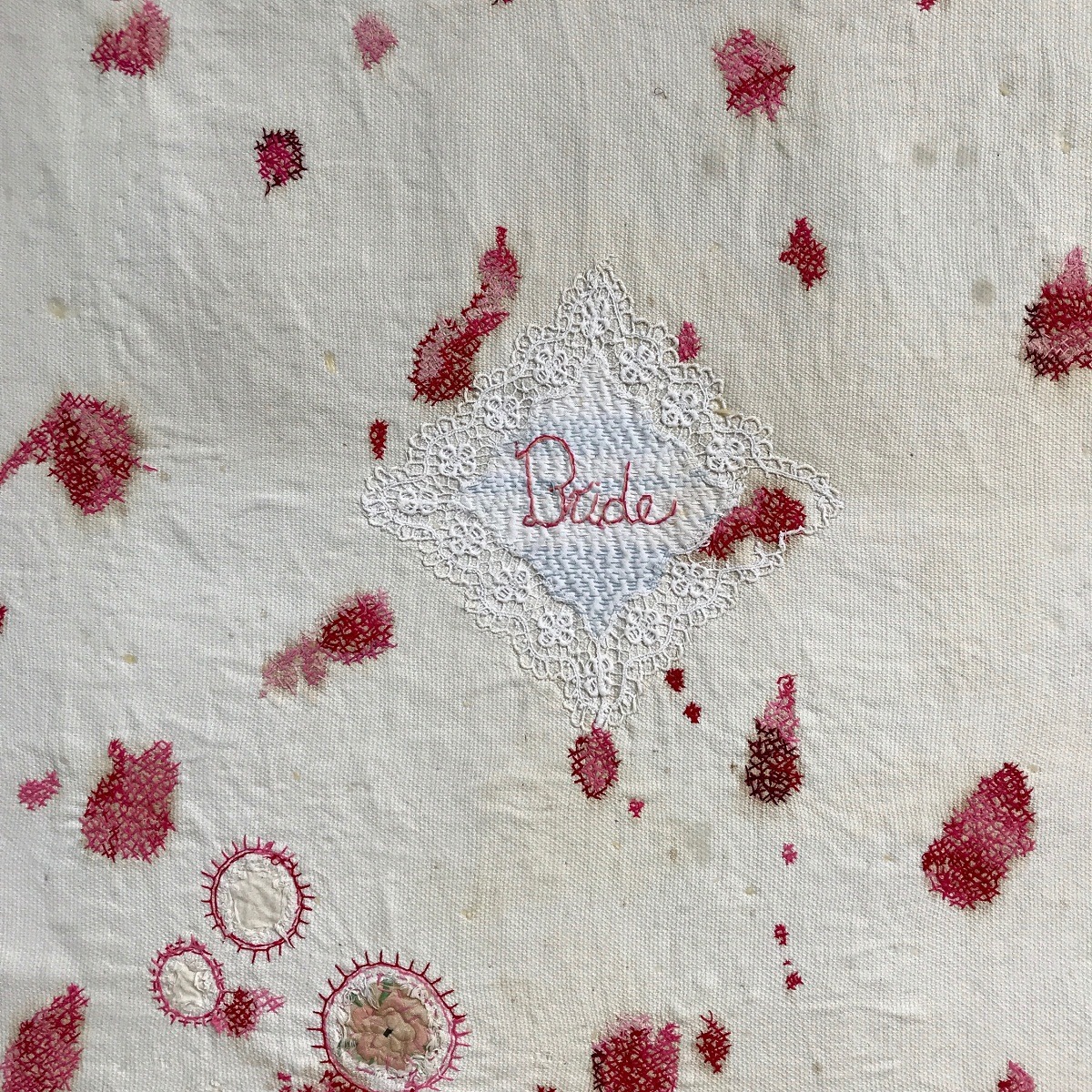
For more information visit www.willemiendevilliers.co.za
How does this article make you feel? Willemien makes a strong feminist statement through her work and by repurposing used and stained tablecloth linen. Let us know what you think by leaving a comment below.
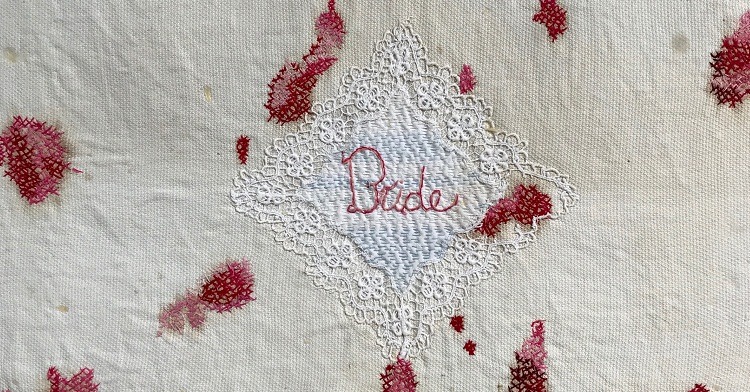

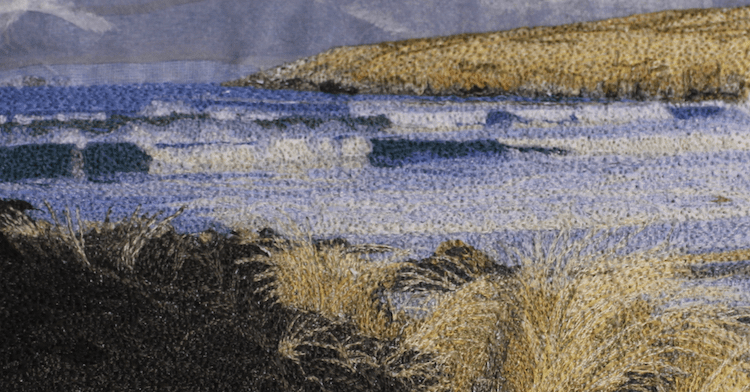
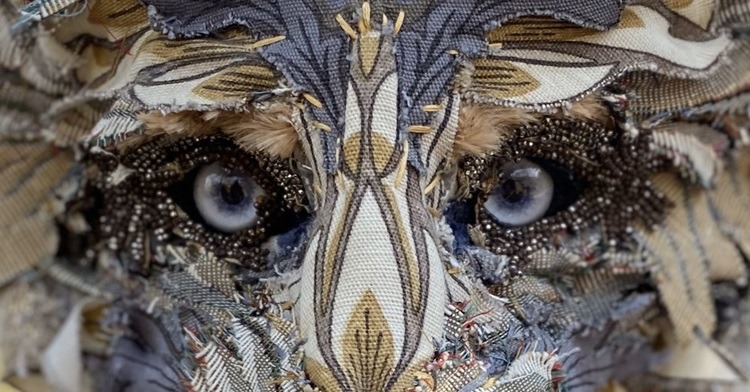
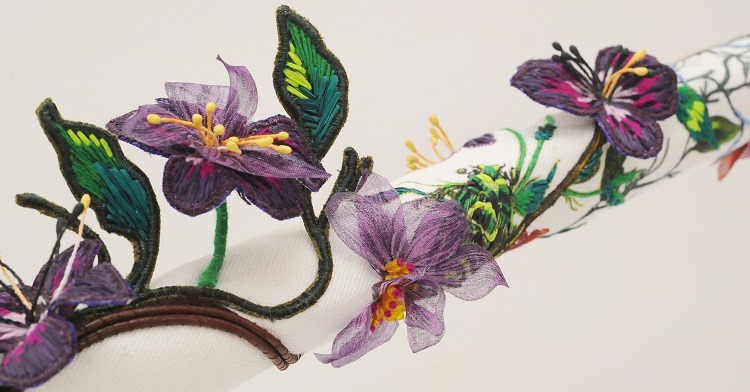
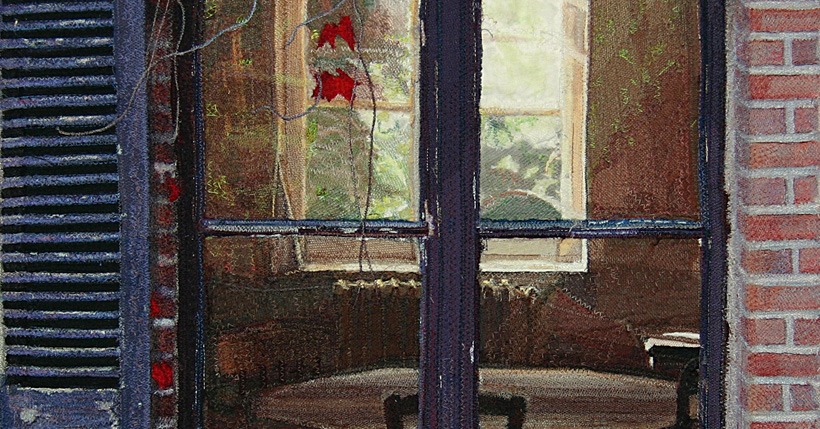
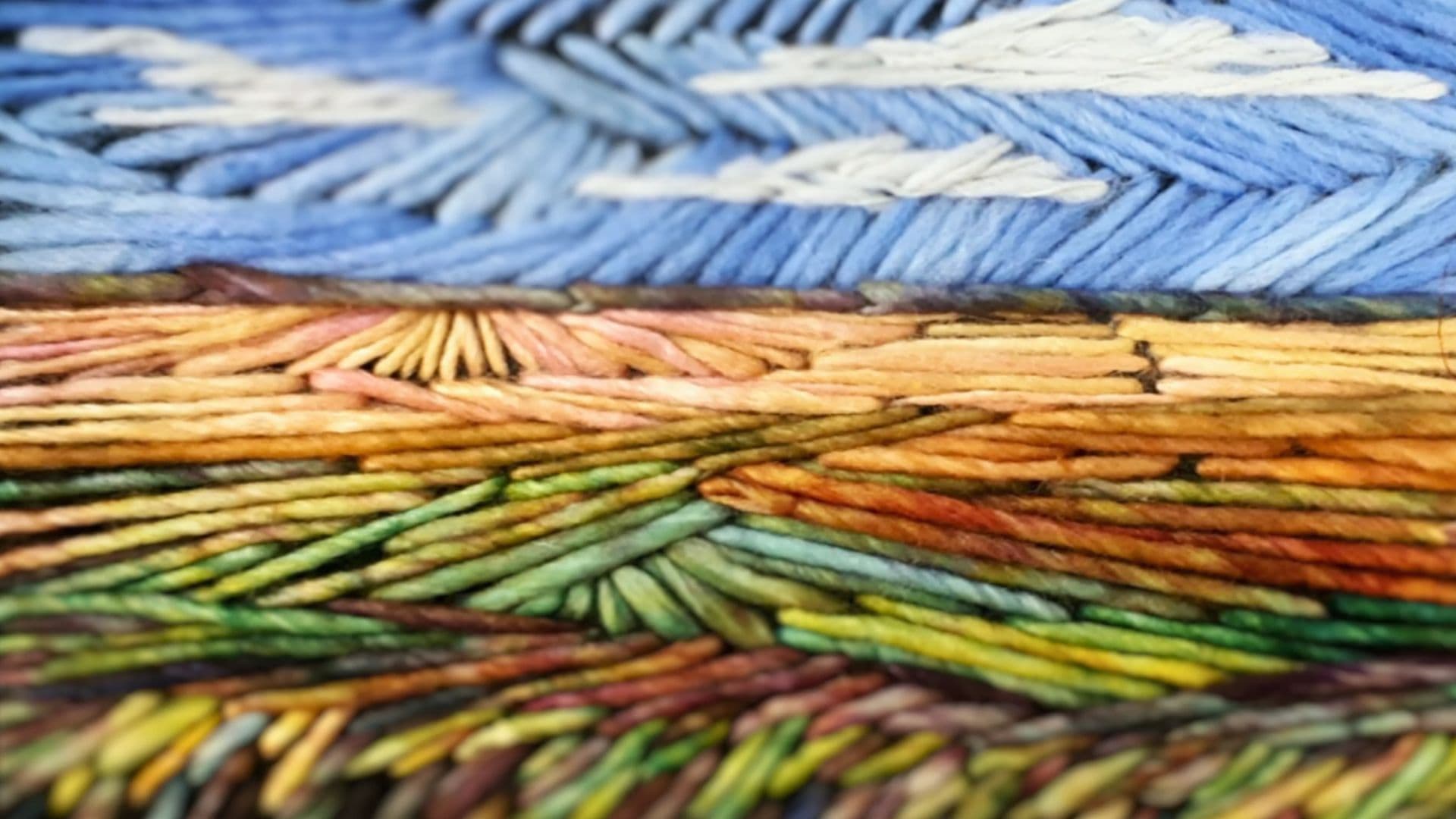
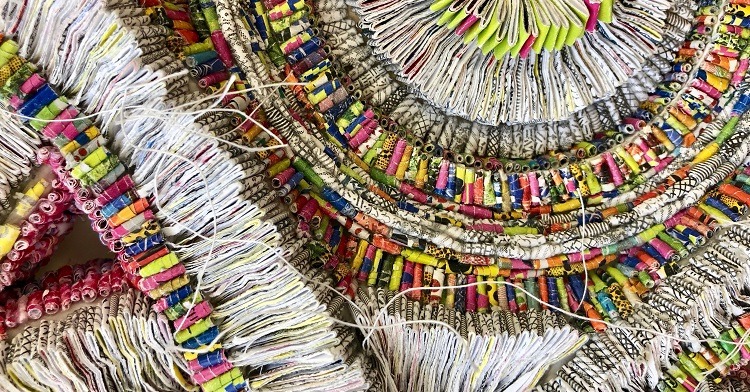
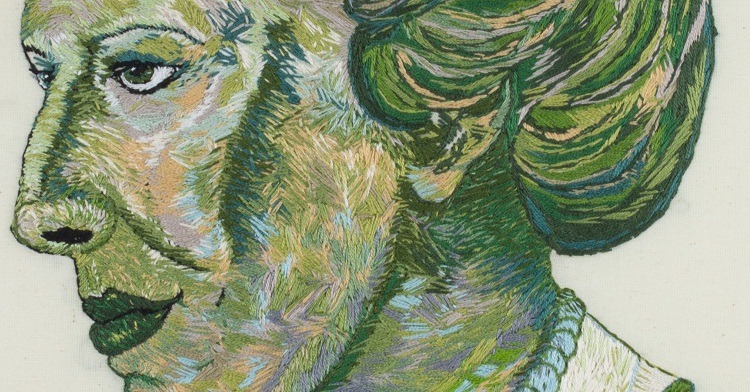
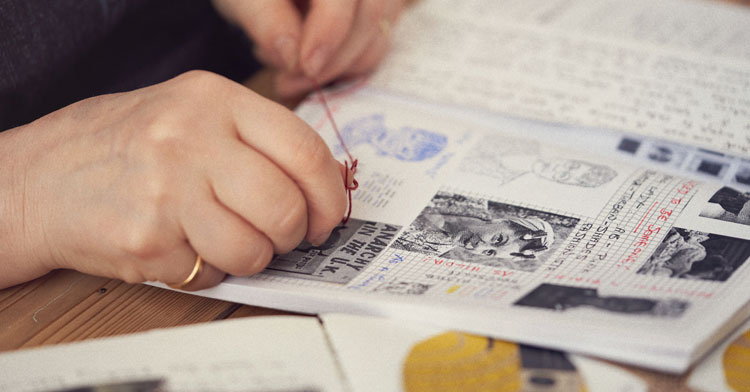
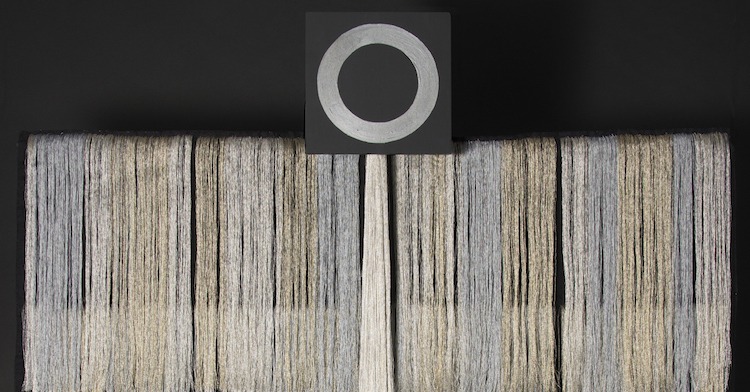
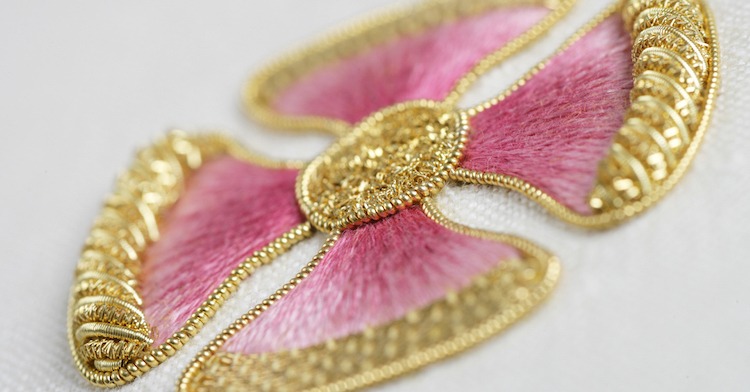
27 comments
Stephanie Templeton
The work is definitely art. How do you display each piece? Are they framed collectively, perhaps they are in own frame or maybe unframed.
leslie venson
I enjoyed the explanation of the process you used. I feel your work expresses both the joy and the sadness that the union of marriage have been for many women especially the more restrictive religions around the world.
Penelope Elliott
Very nostalgic work. Reminds me of my beloved grandmother who had a cupboard with creaky hinges full of old linen and things that belonged to her mother. The linen clothes speak of continuity and security. Something women create in their marriages & families. Lovely work. I liked the pink that defies her old professor too. Thanks Willemein.
PJ Taylor
Enjoyed this article so very much! Beautiful work and extremely inspiring. Thank you so much for sharing your lovely thoughts and ideas.
Noelle A Foye
I am moved by this body of work. It really makes me stop and think about the word bride and all of the meanings that one word can conjure. So complex, so many layers.
Martine
A true marriage let’s you be yourself try not to accept anything less and never lose your creative voic
Gillian at RAGWORKS
Extremely interesting and innovative rebellious work. I like the simplicity of the stitching and the earth-driven colours. I like that DNA has soaked into the vintage cloths and bobs. I agree with hand-sewing being a meditative organic process outside of strict embroidery rules. which serve to keep women in their (domestic) place as well as providing security for women in the form of order and ownership of a territory. Great highlighting of blood as essential menstrual blood a thing which only women possess and know. This is not craft: it’s art borne of artist vision and fluid creativity. It’s unpatterned and personal, Bravo. Like also that the words aren’t necessarily in English.
Sue
Stained bed linen.
Menstruating yet barren.
Lace the web of memories, woven to keep all that is precious safe, respectful.
Thank you Willemien
Betty Bickford
Very inspiring. Thank you! I also use old linen tablecloths, napkins etc in my work.
Clementine Cuppen
Interesting work. But it made me feel sad. So much negativity in this.
Celia De Villiers
Hi, Wonderful work and the textiles are so appropriate to her concept. I have an affinity with the topic as I have made a sculptural work out of , Perspex, wood and vintage textiles on the same topic. Before I re-located to Europe, Willemien and I exhibited together in Cape Town and also share a surname although we are not related.
nancy latham
Really enjoyed reading this article and learning more about Willemiun’s thoughts behind her lovely work which I have seen online.
Margot
Really love this work, thank you
Jessica Porterfield
Oh, my mind is racing! The muted pink just knocked me over with its perfection. What a wonderful, authentic theme as things for women seem to be getting worse and worse in US in my 70 year old opinion.
Sue
Such a moving body of work. Both yours and that of Amy Messiners’ really bring out an emotional response from me. Life can be so sad, so forlorn, so precious.
In New Zealand we called the trousseau box the Hope Chest. These were stashed full of treasured textiles so optimistically stitched when first made. All made by the same medative slow perfect stitching, stitched with such hope for a perfect life, a perfect wife.
Which we know it never is, we can never be.
Kiss Marianne
Oh, what beautiful all your things are! I’m liking them very-very much and congratulation!
Have a nice week!
Marianne
Elizabeth Bunsen
Fabulous article – I love Willemien’s work!!
Jess Staude
Her work evokes strong emotions and a sense of nostalgia. It feels like I have touched and seen those fabrics. I am South African and share a similar heritage and have inherited some of these same pieces. How wonderful to see it speak volumes about a past we never experienced. I studied Textile design and greatly inspired to try my hand at something like this. I printed all my own fabrics and made a quilt when I was a student. I think I should try it again.
Linda
WOW!!! I find your work and the motivation and thoughts behind it to be so very interesting. I’m always picking up old linens in thrift stores and trying to figure out what to do with them. I too am interested in the story of the human condition so, maybe I could find away to talk about it in my old linens as you have in yours. A memoir perhaps. I so wish I could see this work in person. Wonderful, strong and I love that you thumbed your nose at your old art prof and his criticism of pink!
Kathleen March
This is pretty amazing. Thhe article conjured up so many ideas and memories from old, stained linens I inherited from my mother. Now I have the courage to bring them back to life. Thank you so much.
Julia
There is a very profound artistic and social justice statement overall in this artwork but what has most resonated with me is “muted pink”, shades of muted pink -“an apt reference to the narrow, toned down lives so many women are still expected to live”…A very powerful reminder.
Susan Ludwig
Sewing passion plus social statement… Wow!!
Jaclyn Wenner
Willemien’s process isi inspiring. I’m glad to see that she’s taken on a social issue and has found a medium to embellish. I felt some connection. My work is also intuitive. I have done a lot of crazy quilt using lace and assorted embellishments. I have not yet found an issue to pursue.
Joe
Hi Jaclyn – so glad you found the article inspiring. Willemien certainly is a very talented artist. How interesting to hear about your work – we’d love to see an example some time.
Linda E Jurkiewicz
This is amazing work! Thank you for sharing this interview. I too had forgotten about the Hope Chest. My hope is that Miss de Villiers work will strike a chord in women that will help them realize that their commitment to a marriage does not have to mean a soiled and fragmented life for themselves.
Juliet Eberle
I really like what she is doing here but have slight reservations about the literal interpretation of the stains, I think they would be more creatively used if equally repurposed into an alternative design purpose.
Leila Latimer
Oh how moving this whole story and concept are. I am interested to know more especially as my family herstory is similar to the one above.